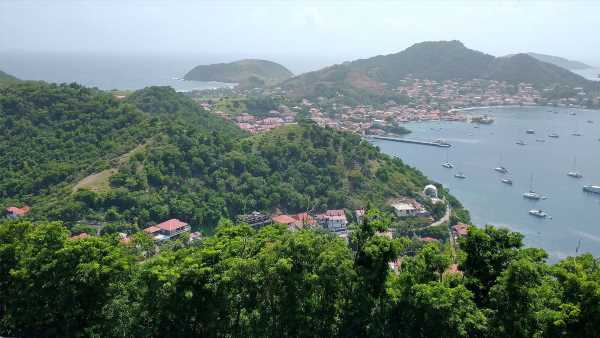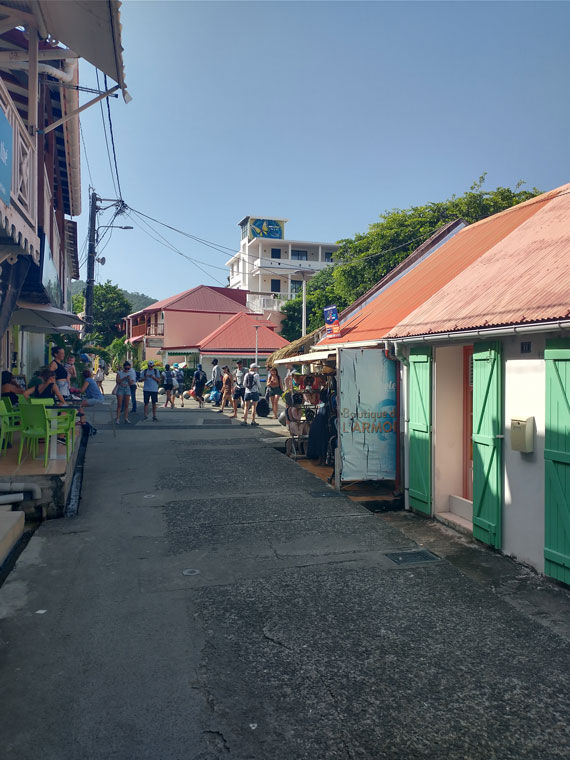
For those looking to go beyond their oceanfront resort in Guadeloupe, the French archipelago offers an
abundance of unspoiled nature that rivals many of its better-known Caribbean neighbors. A drive across the lush, green countryside of Basse-Terre, one of the destination’s two major islands, yields ample
opportunities to spot sugar cane fields, cows and goats grazing in front
yards.
But getting around can be a challenge: The mountainous roads can be intimidating, and rental cars with automatic transmissions are hard to come by. A tour guide is a solid option, as I found on my visit, helping to maximize my time and to navigate the language barrier in a destination where English is not widely spoken.
My guide, Taina Tharsis, the owner of Guadeloupe Explor, made sure I saw many of the island’s landmarks during my November visit.
Our tour began with a visit to Cimetiere de Morne-A-l’Eau, a vast graveyard on a hill where the tombs are all black and white. Red candles flickered across the cemetery during my visit, marking the All Saints’ Day holiday just a few days earlier that honors the departed.
In the town of Baillif, we sampled rum at Distillerie Rhum Bologne, which grows its own sugar cane to produce its spirits. While most rum is made from molasses, rhum agricole is distilled from the juice of fresh-cut sugar cane. The distillery gets its name from master violinist and composer Joseph Bologne, Chevalier de Saint-Georges, who was born in Baillif in the 18th century and whose family once owned the property. He is said to have influenced Mozart and is the subject of a major motion picture, “Chevalier,” that is being released this month.
Culinary delights
On the west coast of Basse-Terre, near the town of Bouillante, Galets Beach offered copious amounts of food in a tropical haven, with tree-shaded, open-air lounges that felt chic yet rustic.
Across the island, menus brim with seafood, including red snapper and mahi mahi. Besides Creole and French influences, elements of Indian and Chinese find their way on menus (both groups served as indentured workers in the 19th century). Colombo curry, for example, is rooted in Sri Lankan cuisine.
The dinner buffet at my hotel, La Creole Beach Hotel & Spa, offered plenty of sampling opportunities, from seafood salads to perched snapper to French desserts and wine. One personal surprise was the first gluten-free, vegan and organic meal I ever enjoyed, at the Kassaverie Widy Grego. Cassava is king there, as its flour is used for most dishes, along with local fruits and vegetables. There’s no menu, and for 25 euros, you get a three-course meal that includes juices and tea.
On the southern end of Basse-Terre and a 20-minute ferry ride from Trois-Rivieres, Terre-de-Haut is a popular tourist destination that offers bistros and restaurants as well as shopping, hotels and beaches and is reminiscent of a seaside French village.
Walking the main district is easy, although longer jaunts may require renting a moped or a golf cart. Terre-de-Haut is also home of Fort Napoleon de Saintes, an 18th-century fort that, while never used in battle, serves today as a museum. Surrounded by a botanical garden, the fort, some 400 feet above sea level, offers a very photogenic view of Les Saints Bay, its rocky bluffs and red-roofed civilization.
While there are more popular beaches in Guadeloupe, such as Sainte-Anne or Grande Anse, Pain de Sucre is a small, hidden gem and requires some local insight to reach it. There is no parking lot, no noticeable markers indicating its existence, and it’s a 10-minute hike downhill on a rocky path to reach it. On arrival, one encounters crystal clear waters suitable for snorkeling and vegetation-draped rock-formation vistas.
On to Grand-Terre
On Grand-Terre, the other major island in the archipelago, hiking the La Soufriere volcano and the surrounding national park rainforest is a popular activity. It takes about four hours roundtrip to the summit and back. Hiking to the Carbet Falls and its three cascades is another popular endeavor, as is Pointe des Chateaux on the eastern side of Grande-Terre. A short hike to that hilltop rewards visitors with serene views of the Atlantic Ocean while powerful waves crash onto the beach and rock formations below.
JetBlue operates three nonstop flights per week between New York and and Pointe-a-Pitre Airport. The destination has no requirements related to Covid.
Source: Read Full Article










